#like how her costumes are elaborate and to us as the audience very feminine.
Text
thinking about padmé and gender. femininity is a performance and she’s winning
#you understand#like how her costumes are elaborate and to us as the audience very feminine.#but in a way that speaks to power#v her costumes that she often wears with anakin which are softer etc etc like#how she’s almost performing a different (sterotypical) feminine role#even if it’s not fully consciously#like i imagine being taught to play a role (the queen of naboo) from a young age to which there are certain expectations attached#(in this case a perception of femininity) would#have consequences#do you see what i’m saying#i will elaborate tomorrow (with pictures)#bc i have a lot of thoughts#but it’s also kind of late and i need to go to bed#padme amidala#star wars#star wars padme#there’s a lot to say generally about gender as performance and the extent of that etc eyc#but past midnight brain is not thinking or expressing it clearly
3 notes
·
View notes
Note
Worst game of thrones hairstyles and why. Go!
Hi! Thanks for the ask! I profusely apologise for the extensive rant that is about to follow.
I thought, before we jump into negativity, I would list some of my faves. I liked the hair more than the costumes, and a few of these were really pretty. Here we go!

These are some of my faves and I will just run through a few of them. Dany’s hair was really good until the enormous braids started coming in. At the start, with a few really pretty braids, and especially when she had her hair down cause it made her look so soft, she looked amazing. It showed Daenerys the queen and Daenerys the girl at the same time. Her hair in these early seasons is what Arya’s should have been. The same goes for Catelyn and Cersei. These styles were understated but pretty, and was all part of Catelyn adapting to the Northern style and Cersei playing on her beauty to fool people. The same goes for Margaery. It incorporated braids and curls in a really fashionable way, matching her intelligence to her need to be underestimated. Sansa’s hair in King’s Landing (when it was down) was pretty too as she adapted to her surroundings and the people around her, but it was still soft and gentle like her. Petyr is here because he looks the most like his book character, I think out of everyone. They really cast and styled him perfectly. Jon’s bun style was the closest to book!Jon he ever got, and though I love his curls, I preferred this to his earlier looks. It helps that it matched his father’s and Arya’s hair, too, so for the first time (because of poor casting) we saw the family resemblance. And these styles for Arya, apart from maybe a few in the HOBAW, were the only times she looked like a Northerner and was allowed to look like a girl. It’s not perfect, as her Northern braids aren’t woven into loose hair, but it did make her look a little wild and were the only times we saw a proper Northern hairstyle done well.
Now, onto the ones I don’t like:

I’ll get these in heere now because they’re not the worst. Joffrey and Tommen’s hair was weird. It’s not the long, golden waves as described in the books, they don’t really look like Lannisters apart from the colour, and the hair itself did not work with the crowns they both wear, especially Joffrey. I don’t know, it’s not terrible, but the men’s hair was mostly unremarkable, so, scraping the bottom for these. And then young Ned. *sigh* Why did 20-or-whatever-year-old Ned have the exact same hair as Sean Bean? He hasn’t changed his hair in 17 years? Lazy and boring and makes no sense. He should also have darker hair but that’s a book thing, so…
From now on, we’re gonna tackle this by character. Up first: Margaery Tyrell
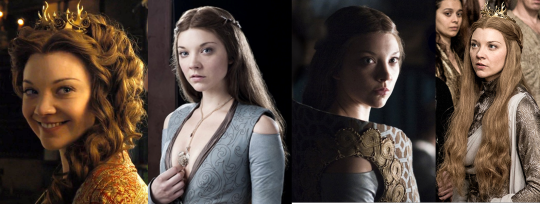
Margaery almost escaped this list because her hair was often really good. As with the outfits, I know she was supposed to be pious, but the hair was a miss in that situation. It was basic and boring, and so far removed from the Margaery we had seen before. Why is her hair straight all of a sudden when it has always been curly? And the way she tied it back when she wore that awful dress in season 2 looked very strange. As for her wedding with Tommen, there was the opposite problem. As Tommen was younger, she needed to look more innocent and sweet, but instead they went over the top to make her look elaborate and rich, almost emphasising that her family was ambitious. Normally her hair and clothes struck a balance between innocent and ambitious, but this just went too far and it didn’t really fit her face. Though, I have to say, I don’t despise any of Margaery’s looks.
Now, Cersei Lannister

Some of these just made absolutely no sense. The helmets of braids she got, one of which was lopsided, just looked awful. It was far too much and they’re never seen again, which shows how bad they were. I don’t even know what her hair was supposed to be during the tourney but it didn’t work at all. And her short hair didn’t always look terrible, but it got far too shaggy for a Queen and here it didn’t fit the clothes she was wearing in this picture.
The Sand Snakes

Once again, I am simply bored by the Dornish characters in the show. There is no variation or variety, very little thought put in other than hair that might be useful in battle. They didn’t care to give them anything interesting and it shows. Where is Tyene, with her flowing golden hair? Where is Nymeria’s soft but deadly features? Where is the variation? It’s boring and does a disservice to the Sand Snakes.
Sansa Stark
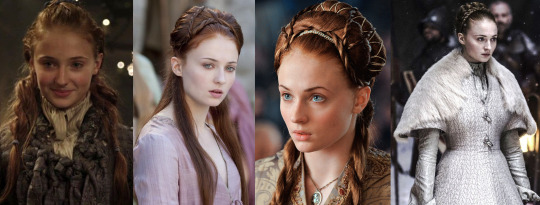
I liked Arya’s northern braids, but Sansa’s version did not work. They were a lot messier than Arya’s (ironic, isn’t it?) and it wasn’t styled properly to fit the image of a proper northern/ southern lady. She would have been better off with hair more like her mother’s rather than braids, both aesthetically and storywise. Her hair in King’s Landing early on was similar to Cersei’s, which was definitely a bad thing. Her hair, which looked like a massive headband, was not as bad as Cersei’s version, but it wasn’t a good look. There were no strands or enough loose hair to properly frame the face, so that became the only thing to focus on and it didn’t work. Now, Sansa’s second wedding looked alright mostly (though I was not the hugest fan of the dress but I’ll get into that in another ask) but the hair was an issue story-wise. There was this thing going on with the Starks, supposedly the wildest and most rugged of the great families, where their hair was constantly super tight and pulled back, restrained when it should be free and wild. I know Sansa was being held against her will, but this wedding is also to give the Boltons a claim to Winterfell, so they needed to emphasise that she was a Stark, and that includes having Northern hair.

And once again we have the opposite problem. Her coronation hair had nothing to it. It was completely straight, unadorned and had no northern-ness to it at all. There were no waves to give it a bit of depth. It was super plain, boring and unimaginative. Then the Dragonpit, though it looked good, at that point Sansa had betrayed her Northern heritage and her family, so she shouldn’t have been the most northern-looking person on the screen. Once again, this is a style that Arya should have had, not Sansa.
Arya Stark

Just like the costumes, she had the same hair for 3 seasons. It got old quick, especially when she has different hair in the books during this time. It made sense for 1 season, not 3.
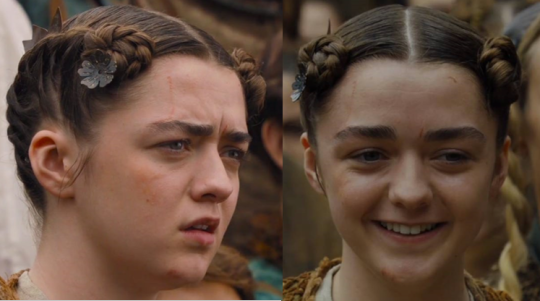
This monstrosity was one of the worst hairstyles in the show. The one time Arya gets the chance to dress like a girl, and this is the hair that goes with it? Really? It didn’t frame her face well, it reduced the feminine aspects that Arya was finally getting to express, and was a clear attempt to infantilize Arya and prevent the audience from thinking of her as a woman. It was also not a very nice style on its own; the buns should have been further back, but that would have been space buns and so very inaccurate, so she should have just worn it down anyway. Huge miss on this one. Super ugly. Only upside is she finally got the blue flowers she deserved.

This is what I said about the Starks having restrained, pulled back hair and it’s especially egregious for Arya, who is sooooo Northern and so wild. She needed her hair down, with braids woven in, longer and more natural. Instead, her hair looks like it’s covered in tar and there is nothing natural or northern about it. Once again, I am bored by the looks. And she kept this for two seasons straight, never changing. It’s ridiculous. The makers of this show just didn’t care about Maisie or Arya and it shows visually. It makes no sense for the princess of the north to have the same hair and clothes for years, with zero variation, especially when Sansa and Dany are out here with a new look every episode, sometimes two in a single episode.
This is what Arya’s hair should have looked like:

It’s extremely disappointing what we got instead.
Daenerys Targaryen

I mostly adored Dany’s hair, but as the seasons went on her braids got more and more elaborate and fake, and it started to become painfully obvious that it was a wig with huge braids stuck on. The looks with huge buns in the back just looked a bit silly, and I feel bad for Emilia who must have been so weighed down by all of that on her head. The braid she wore beyond the wall, and the one on the bottom row second from the right, were just a bit messy. As I said, her hair became a bit insane as it went on, making it less believable and less beautiful. And her finale hair, whilst fine from the front, was the most obvious example of braids being stuck on. It was basically a helmet and it made no sense. The braids were far too big and it didn’t work.
Sorry for the rant, nonny, but thank you for the ask!
#anti got#anti d&d#got hair#daenerys targaryen#arya stark#sansa stark#catelyn stark#cersei lannister#margaery tyrell#neve has mail
84 notes
·
View notes
Link
Emmy Voters Shouldn’t Take Netflix’s ‘The Crown’ For Granted, as It’s The Last Chance to Reward Beautifully Understated Work
Season 2 is the final chance for "The Crown" stars like Claire Foy and Matt Smith to collect Emmys as they move on to other opportunities and new stars step in.
Netflix’s lavishly appointed Season 2 of “The Crown,” which takes place from 1956-1964, landed the same number of Emmy nominations as last year (13). But the series faces a mighty lineup of dramas this time, including Season 2 of last year’s winner “The Handmaid’s Tale,” as well as the penultimate season of “Game of Thrones” and the lauded final season of “The Americans.” This intense race could be close.
Netflix knows how to campaign, and the royal saga is popular, which would appear to give it an edge. But many Emmy voters seem to take for granted how well the team led by showrunner Peter Morgan (“The Queen,” “The Audience”), who writes and delivers all ten episodes at the start of each season, pulls off an historic costume drama on a fast-paced television schedule, complete with elaborate period sets and costumes. At a hefty $6 million-$7 million per episode for 20 episodes (a total $130 million), Morgan calls it “cinematic television.”
“He doesn’t mess around,” Smith told me. “It’s the only show I’ve ever been on where all ten scripts are in pretty good lick. He manages these characters and episodes and stories we think we know well and finds an interesting angle of approach.”
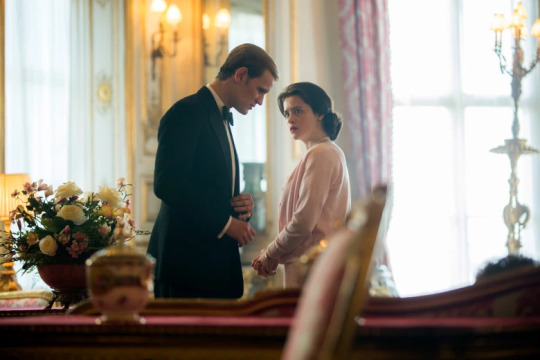
The Crown (L to R) Prince Philip, Queen Elizabeth discuss Charles’ education [s2e9] Robert Viglasky / Netflix
And the acting is top-notch too, led by Golden Globe-winner Claire Foy (“Wolf Hall”) as rock-solid Queen Elizabeth. The Queen is trying to hang on to her fragile prime ministers as well as her dashing swain Prince Philip (Matt Smith) and keep the peace with her hipper sister, stylish Princess Margaret (Vanessa Kirby), who recovers from a broken heart by falling for swinging photographer Anthony Armstrong-Jones (Matthew Goode). All earned nominations this year; last time only John Lithgow as Winston Churchill took home an Emmy statue.
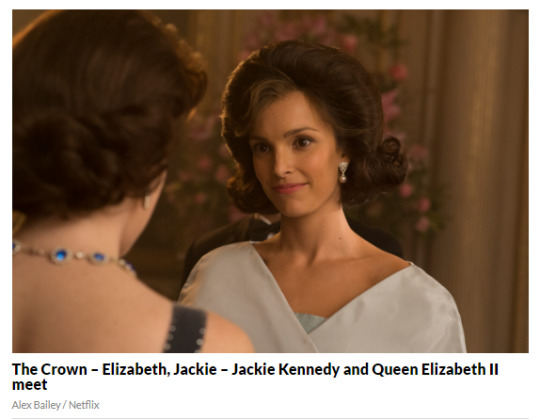
It’s the last round for this cast, however, as Season 3 sends in an replacement crew to play the Royals as the hit middle age, including Olivia Colman (“The Night Manager”) as the Queen, “Outlander” villain Tobias Menzies as Philip, and Helena Bonham Carter (“Sweeney Todd”) as Margaret. While the original cast are wistful to leave the “The Crown” family, they’re moving on to opportunities aplenty. Before Season 3 started filming, Kirby was in touch with Bonham-Carter every day, sending her a music playlist for Margaret. “I’m grateful to get to share Margaret with somebody,” she said. “My obsession is extreme!”
Morgan did not know when he started how popular the show would be, but he signed his stars for only two years. “I don’t think it’s fair to ask an actor to age more than 20 years,” he said at a TV Academy panel. “If we’re going to be doing 60 years, it’s not fair for them to spend five hours in makeup every day. But it’s hard for me, now that I’ve got used to how Claire is. I’ve hit my stride in writing for her, it’s writers interruptus. You meet these wonderful actors and discover what they can do. The same with Vanessa. The new cast will present new challenges–it’s hard enough without new challenges!”
Smith had already experienced giving up a popular role with Doctor Who. “I’d rather do two years than seven,” he said.
While Smith (“Doctor Who”) and Goode (“The Imitation Game”) are fairly well-known, both Foy and Kirby launched film careers with the series, from Foy’s punk hacker Lisbeth Salander in the upcoming “Dragon Tattoo” sequel “The Girl In the Spider’s Web” to Kirby’s flirtatious turn opposite Tom Cruise in summer smash “Mission: Impossible–Fallout.” Meanwhile, Smith has taken on two creepy characters, Patrick Bateman in London musical “American Psycho” and Charles Manson in upcoming “Charlie Says.”
The issue of who got paid what has hovered over the series. Although Foy was cast first as the Queen of England and commanded more screen time, she was less established at the start than Smith, who broke out as a star in Doctor Who and had salary leverage when Morgan insisted on casting him because the chemistry with Foy was so strong in their auditions. “There was electric, immediate energy in the room,” said Morgan. “The producers said, ‘look, we’re in negotiation, does he really have to be Philip?’ ‘There is no option. It has to be him.'”
So they paid him more than Foy.
“I find a huge amount of support around me and in the industry and around the world,” said Foy of her unequal pay vs. Smith, “knowing that if I don’t speak up and support myself than nobody else will. You have to be your own advocate, without being difficult, and be willing to step away from something you don’t agree with. That’s happening and it’s extraordinary.”
If Season 1 set up the royal stakes in the central fraught marriage between dashing Navy man Philip and the Queen to whom he had bow and kneel, it was also a hard act to follow. All the directors came back to shoot Season 2, including Stephen Daldry (who cherry-picked episodes eight and nine). There was more color and travel, roving from Tonga, Ghana and Papua New Guinea to the Antarctic.
With Season 2, the team moved with more confidence into the story that digs deeper into Queen Elizabeth’s relationship with her husband and her prime ministers, such as Anthony Eden (Jeremy Northam), as he colludes with Egypt on the Aswan Dam. Fashionably modern John and Jackie Kennedy come to Buckingham Palace. And old-fashioned Elizabeth faces harsh criticism from one politician, Lord Altrincham (John Heffernan), causing her to change the stilted way she speaks in public.
The cast who played royals practiced the accent constantly. “We spent all our time speaking it on set,” Kirby told me in a phone interview. “It must have pissed off the crew. We were all in it together. I tried to find a middle ground, we didn’t want to alienate people too much, I tried to make my voice slower. She sounds different by the end of the season, we’re growing up with them. “
As Morgan writes the episodes himself, he doesn’t have a writers’ room, but a researchers’ room. He sifts through history, dumping the obvious stuff in favor of delicious details that might surprise or upend conventional wisdom. “It’s an absolute joy, as a dramatist, looking at the intimate and the epic,” he said. “They are just like us and they are nothing like us.”
On “The Crown,” where the Queen tends to keep a stiff upper lip, a scene between Jackie and Elizabeth having tea and scones is as dramatic as it gets. “I’ve long been writing this for so long, everyone is so polite, I’m desperate for a fight scene,” Morgan said. “I long to write a punch-up, there’s been no blood on this show for 20 episodes. That scone was my fight scene. She buttered the scone irritatedly.”
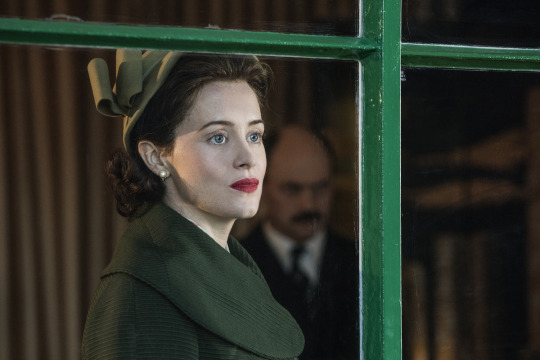
Claire Foy, “The Crown” Stuart Hendry / Netflix
Most dramatists don’t pick an introverted, shy, middle-aged woman as their central protagonist. “With someone like Tony Soprano, any emotional response was valid: kindness, cruelty, gentleness, butchery sexiness,” said Morgan. “You don’t have that with the Queen. You’ve got her trapped within this other thing: it is very Russian doll. You’ve got the woman within the woman within the thing that is not the woman– the Crown–which is not gender specific, neither feminine or masculine. How a woman connects with that is complex, so she’s lost some of herself. She’s not an articulate person, so you can’t go on and on to explain that complexity. So someone like Claire is skilled enough to do it in repose. So you never feel that the character is not complex, because you’ve got an actor skillful enough to give you that, even in silence.”
In the editing room, Morgan found that whenever there was a missing transition he learned to rely on Foy’s reaction shots. “When Claire was on screen the whole thing was settled,” he said. “That wouldn’t involve her throwing plates. It was just the strength of her performance and how completely she inhabited the character, and how she as an actor in that character could give the whole thing an orientation and center and an anchor. As the Queen gives anchor and stability to the country, so Claire was doing in our show.”
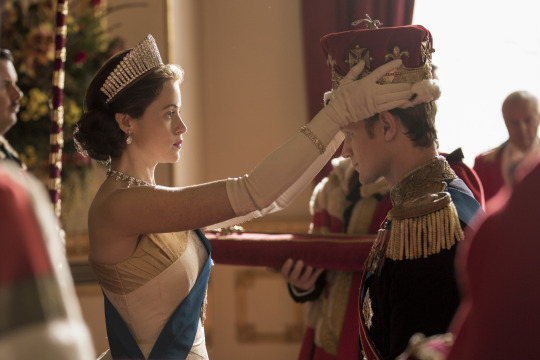
Luckily Foy has always been a reactive listener. “I love being in a scene and not thinking about anything but what that character is thinking,” she said. “I’ve always loved listening and being able to think like the character. And this show appreciated a character who doesn’t go forward, but sits and lets people come to her. And not many shows appreciate that, they don’t put someone at the center, who’s just being and listening.”
Smith is Foy’s exact opposite. He brings a competitive athlete’s physical masculinity to Philip. “I quite like Philip’s maleness,” said Smith, “which in this day and age is interesting. And Elizabeth liked that about him.”
“Philip is a tough man,” said Smith. “Charles notoriously wasn’t, he’s the antithesis of Philip, emotional and sensitive. Philip is those things deep down. But he was growing up in a different time, he had to grow up quite quickly. He went through death and tragedy as a young man. He was essentially orphaned.”
Foy and Smith were opposites as actors. “We work in different ways,” Foy said. “We brought out in each other instantly a friendship, we’re able to give each other what we needed. Matt wants to try new things and get an extra take; I’m ready to go on the first take, to be real and never do it again. That was a tricky thing to negotiate.”
Foy admired Smith’s willingness not to make audiences like Philip. “He’s masculine and feminine, able to be emotional and vulnerable and bit of a love,” she said. “He can be incredibly selfish and you still like him, he has the gift of being likable.”
At the end of the series, as pregnant Elizabeth is lonely and isolated at Balmoral Castle in Scotland, scandal-plagued Philip finally comes to her on his knees, a supplicant. “That scene was a pain in the ass,” Smith said. “It took three days. The history is tricky. How much of it to reveal, a sensitive subject, that. With the Queen of England you never acknowledge the fact that Philip was over the abyss. I look at it as a man on his back foot fighting for his life. Whatever you say, they endure. They are a team. He makes her laugh.”

“The Crown” Alex Bailey / Netflix
On the other hand, Vanessa Kirby as Margaret gets to open up more. “The biggest gift was that she feels everything so deeply,” she said. “Whatever color of emotion she’s having is 100 percent. Claire is the master of subtle and internal; I’m sweating and spit is coming out. Margaret’s emotions are all on the surface, while Elizabeth’s are buried.”
In Season 2, Kirby gets to smash up her room a bit. Margaret is “someone in pain who descends into something quite scary,” she said. “Along comes Tony Armstrong-Jones and she meets him when she’s in the worst place.”
In the first cycle, Foy got to wear an elaborate wedding dress; now it was Kirby’s turn. “I’m not very fashionable, I wear jeans and shorts,” said Kirby. “Margaret taught me a lot, to express my internal life through costumes.” She and the costume designer Jane Petrie spent weeks choosing ratios and shapes and fabrics. “Her costumes are an indication of where she was at. Even when she trashes her room she’s wearing a gothic robe. The next morning, she’s pale in a yellow granny nighty, she had lost all sense of her identity. I wanted to take her on a journey to show how Margaret finds her place in the world. She’s born into something she couldn’t escape from.”
Meanwhile, Margaret yet again has to seek Elizabeth’s permission to marry. “I didn’t want to overplay it or underplay it,” Kirby said. “It’s a mixture of resentment and intense need and exhaustion and vibrancy. She is in active denial, looking away from Tony who is massively disloyal and destructive and dysfunctional for her. All those things in one scene feels quite scary.”
41 notes
·
View notes
Text
The Rose of Highgarden. On Margaery Tyrell (part 2)
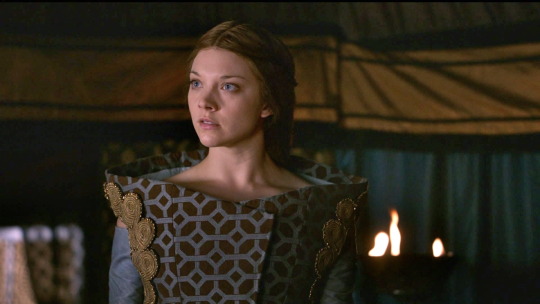
This is the second part in a series of metas about Margaery Tyrell in Game of Thrones (Part 1). In the first part I wrote about Margaery’s narrative arc and her characterization in season 2 - the season where’s she first introduced. In this post I will take a closer look at her costumes in this season.
Costume design is a particular interest of mine and Game of Thrones has some of the most interesting costumes on television - especially when it comes to the female characters. The award-winning costumier Michele Clapton’s work for the show is very original and in several cases visually arresting. However, a lot of fans have complained that the costumes are not medievalist enough. While I do think that this argument has some merit, I personally have no problem with the fact that Clapton’s work isn’t very medievalist. Whilst the feudal society of Westeros is largely inspired by 15th century England, it is also a fantasy world and that means that the costumes don’t necessarily have to be period specific.
Clapton’s decision not to go medievalist is a conscious choice since she has previously worked on period pieces such as the Jane Austen adaptation Sense & Sensibility (2008) and the English Civil War drama The Devil’s Whore (2008), for which she won a BAFTA. Instead, she has chosen to take inspiration from both history and high fashion:
“I look at contemporary fashion and art,” she says. (x)
When it comes to the costumes of Game of Thrones, Clapton have taken a very eclectic approach with inspiration from a number of different sources: historical costume, contemporary couture and vintage fashion. While her costumes may not be “historically correct”, which btw is a bit of an anachronistic concept when it comes to fantasy, her eclectic approach has yielded a number of original and iconic costumes that have prompted a number of articles in various news outlets.
Whilst a number of fans have decried her costumes as ugly, they overlook the fact that in television and cinema, costume design is not just about making pretty clothes - rather it is about supporting and articulating the characterization in relation to the narrative.
Even in real life, clothes is more than just about functionality and aesthetics. It is also a form of communication, which is why there’s an entire discipline dedicated to the communicative aspects of clothing that is called fashion semiotics.
Semiotics is the study of how people understand or make sense of life events or relationships. It is the study of sign processes and meaningful communication. Likewise, fashion is a language which holds a symbolic and communicative role. It helps express one’s unique style, identity, profession, social status, and gender or group affiliation. Therefore, the semiotics of fashion is the study of fashion and how humans symbolize specific social and cultural positions through dress.
Garments are non-verbal signs that can be interpreted differently depending on the context, situation or culture. Hence, fashion significance is constructed depending on culturally accepted codes. For example, in Western cultures white color is chosen for weddings because it represents purity while in Asian cultures this color means death and is most likely used in funerals.
Dress codes identify individuals within a culture. (x)
The same thing applies to how costumes work as meaningful elements in a visual narrative - and this is exactly the approach that Michele Clapton has adopted for her work on GoT:
For her, the key is looking at costume design as a mode of storytelling. “It’s so easy to draw a pretty dress in a fun way,” Clapton told Fast Company. “But this is so much more about finding the right look and telling so much more about that character, and that’s what I really, really enjoy: the storytelling.” (x)
Therefore, when we look at the costume design in this show, we have to ask what it says about the characters.
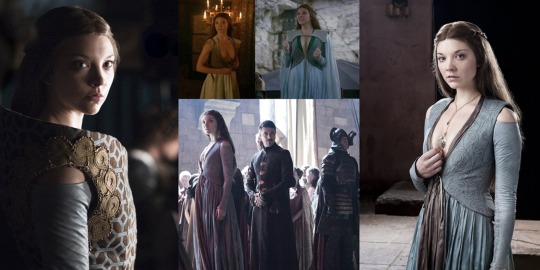
So what does Margaery Tyrell’s costumes say about her in season 2?
BOLD AND SEDUCTIVE
Margaery has three different costumes in season 2. Two of these dresses have the same basic design and silhouette whereas the third is perhaps one of the most unique costumes in the entire show. I’m going to start with a look at the gown we see in Margaery’s last scene in season 2 - the light blue gown with the rocaille pattern on the bodice.
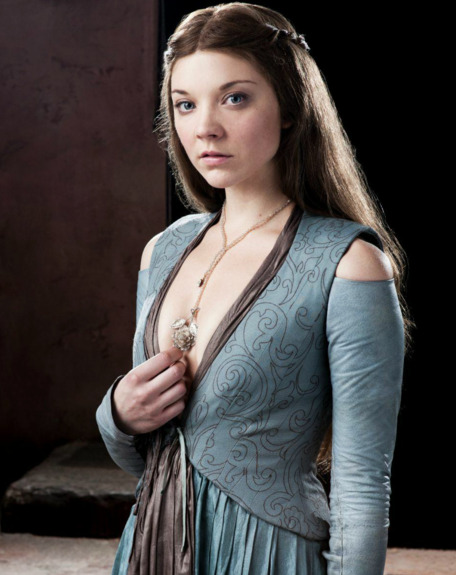
Unlike the red-gold costumes of the Lannisters in season 2, Margaery’s costumes don’t use the green-gold colours of House Tyrell. This is something that a number of fans objected to but this article argues that the use of light colours such a soft blue and purple serves as a subtle contrast to the power dressing of the Lannisters. The Tyrells are just as ambitious as the Lannisters but they are subtle about it and with the use of soft colours, they make themselves look non-threatening whilst they secret plot to extend their political influence.
This dress also feature a rocaille pattern on this bodice. In an art historical context, rocaille denotes an exuberant and elaborate form of ornamentation associated with the rococo style of the 18th century.

The aristocratic culture that the rococo style is associated with was in many ways a hedonistic, sophisticated and somewhat frivolous culture that put a lot of focus on the love of pleasure. In the context of this costume, the use of the rocaille pattern may serve as a hint that the culture of the Reach, which the Tyrells rule, is one associated with abundance, pleasure and cultural sophistication.
Another aspect of this costume is that it is quite revealing - as we’ll see in season 3, the costumes of Margaery Tyrell and her ladies feature a lot of cut-outs as well as plunging necklines, which hints at the warmer climate of the Reach as well as a more hedonistic culture than what we see in the North and the Crownlands. The most noticeable element of this dress is the plunging neckline, which emphasizes Margaery’s bold sexuality. However, the revealing nature of this gown also works at a metaphorical level:
Cersei hides behind her clothes, and Margaery instead chooses to expose herself. A very nice and metaphorical way of showing to the people at King's Landing that she has nothing to hide. This also allows her to expose large amounts of skin, which not only helps cement the idea that the Tyrells come from a warmer weather (as mentioned earlier) but also helps cement the idea that she uses her sexuality and femininity as a political tool in itself. Presenting herself as a young, delicate and alluring girl, she avoids being perceived as a player in the game, even though she very much is. (x)
It is thus ironic that Margaery wears this particular outfit in a scene where she is dishonest when she talks about how she’s come to Joffrey from afar. In this scene Margaery acts bashful and girlish, the role of the innocent maid, which the audience already knows is an act.
During the entire conversation between Joffrey, Loras and Margaery, she utilizes a specific kind of performative femininity, i.e. she tailors her courtly performance so it conforms to a very specific ideal of femininity: the bashful and innocent maid. Notice how she initially keeps her gaze lowered, signalling meek sub-mission. When Joffrey professes his admiration of her, she lifts her gaze and bats her eyes at him, which is a very calculated move. (x)
This is underscored by a costume where the sexy neckline stands in contrast to the softness of the light blue colour. In this context, it is interesting to compare and contrast Margaery’s costume with one of the dresses that Sansa Stark wears in season 1.

Whilst the colour is very similar, the cut and silhouettes of the two gowns couldn’t be more different. Sansa’s gown is modest and loose, hiding her body, whereas Margaery’s gown is close-fitting and very revealing. This highlights the differences between the two characters. Sansa IS an innocent young girl whereas Margaery is a sexually confident woman who simply plays the role of the bashful maid.
FASHION QUEEN
Let’s take a look at the costume Margaery wears when the audience is introduced to her character. First of all, this gown is identical in design to the light blue gown I mentioned above. However, in this scene Margaery has donned a rather unconventional cloak that stylistically sets her apart from any other female character we’ve seen so far.
Like the gown above, this outfit emphasizes Margaery’s confident sexuality. Not only does it have a deeply plunging neckline but the beaded strings that are attached to the button at the front of the cape serve to draw visual attention to her exposed cleavage.

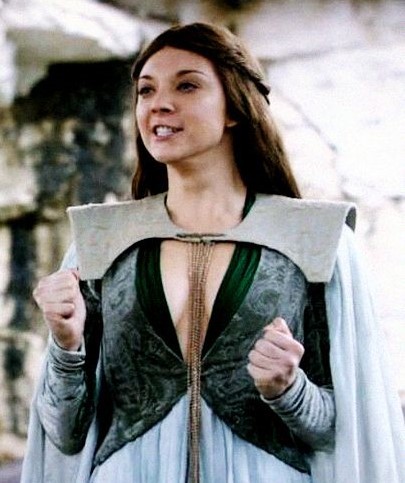
Apart from the plunging neckline, the most visually arresting element of this costume is the structured shoulders of the billowing cloak. This gives the outfit a slightly armoured “feel”:
She dons a billowing cape with structured shoulders that give a sense of armor. It is interesting to note the armor-like aspect of most of Margaery’s season two outfits. She spends the majority of the season at Renly’s camp in Storm’s End while the Tyrell/Baratheon forces prepare for war. Without the security of castle walls for protection, perhaps this is her more feminine way of being always armed and on guard for whatever is in store. (x)
The armoured aspect is an interesting one in terms of character. However, in relation to this costume the armoured “feel” of the shoulder piece takes on a rather tongue-in-cheek aspect since it is paired with a very lightweight fabric that billows in the wind. This is play-acting, which resonates perfectly with Margaery’s presence at a tourney where knights play at war whilst a real war rages elsewhere. However, this costume also signals that Margaery is fashion-forward in a sense few other Westerosi women are. She’s the consort of a royal pretender who wants to present an alternative to the current regime - and Margaery mirrors that by setting herself up as stylistically different, as a future taste-maker.

It is interesting to note that Margaery wears a kind of scarf underneath the bodice in order to make the neckline LESS revealing. The tent scene with Renly shows EXACTLY how deep the neckline really is.
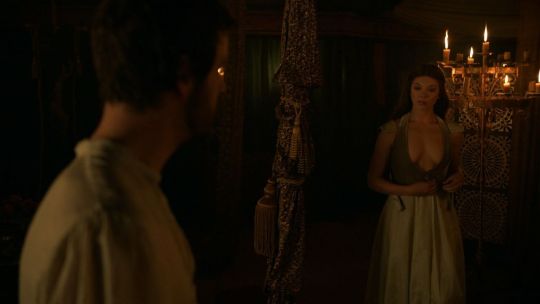
Here the revealing nature of the costume supports both the narrative and the character. In this scene Margaery tries to seduce her reluctant husband but she also reveals her pragmatic nature - as I’ve detailed in my previous post.
ARMOURED IN FASHION
The third costume that Margaery Tyrell wears in season 2 is perhaps the most avantgarde and also the most controversial costume on the show. I am, of course, speaking of the now infamous funnel dress that Clapton designed as an homage to Alexandre McQueen’s iconic Bell Dress that he made for Björk in 2004.

Margaery's funnel dress was obviously an homage to the wonderful Alexander McQueen's costume for Bjork. It just felt right that this young ambitious girl would be experimenting with shapes, honing her style skills which we now see her employing to great effect. It was a risk and divided the audience. (x)
“From the very beginning she is brave and experimental in her look, which I wanted. She was a young girl who wanted to be the queen,” Clapton explained.
Margaery is often spotted in revealing or outré outfits. One episode she wore a funnel dress that Clapton told Vogue was an homage to an Alexander McQueen dress made for Bjork. “It was ridiculous. She’s a teenage girl trying things out.” (x)
Clapton designed this dress to emphasize that Margaery is rather avantgarde in terms of style. She’s experimenting style-wise but this look is so radical in relation to the rest of the fashions of Westeros that I cannot help but think that she’s also trying to create a new paradigm. She wants to stand out, to be seen as different from everybody else.
Another aspect of the funnel dress is that it has an armoured “feel” that is even stronger than the structured shoulder piece she wears at the tourney. The dress itself is made from a much heavier fabric than her low-cut, lightweight dresses and it has a very structured silhouette - and in contrast to her two other gowns it covers her completely.
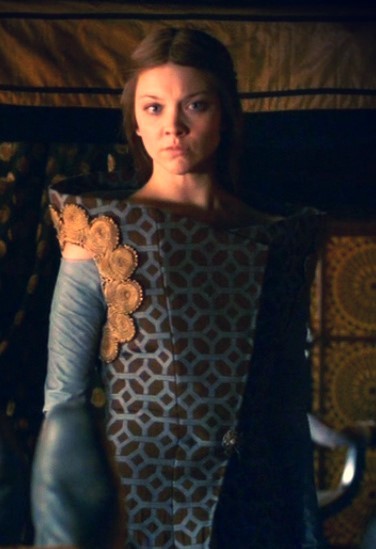
The funnel dress essentially functions as a structured coat-dress that Margaery wears over one of her more revealing dresses. If you look closely, you can see that the blue sleeves with the cut-outs over the shoulders match the seductive blue dress that she wears in the scene where she’s betrothed to Joffrey.
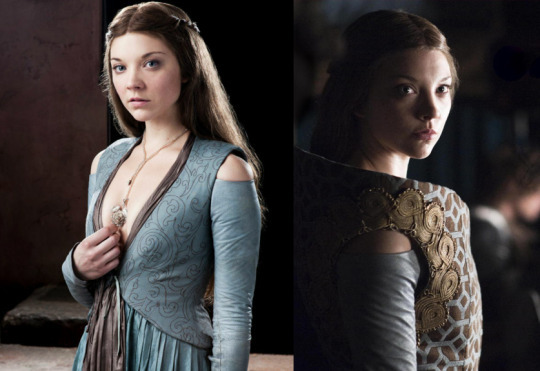
Once again, the costume design supports the overall narrative since Margaery wears this dress in two scenes where she is in a defensive position - Lady Sansa Stark was taught that courtsey is a lady’s armour but for Margaery, fashion can be armour as well:
We witness Margaery’s armor full-on with her infamous “cone-dress”. She wears this in two scenes, and is speaking with Littlefinger in both. She knows this is a man with whom you must always be on your guard, and this is reflected in the heavy satins and silk embroidery, but she keeps her shoulders exposed just enough to maintain a feminine air. (x)
It is noteworthy that Margaery only wears this dress in scenes where she is in a defensive position. The first time in the scene with Baelish where he’s questioning the status of her marriage to Renly and the second time after Renly’s death where Margaery is quietly scared because she knows exactly how dangerous the situation has become for both herself and her family.
TOO AVANTGARDE?
The funnel dress turned out to be a very controversial costume in terms of audience reception. It was the subject of a number of think-pieces but here I’ll just focus on article since its arguments exhibit a couple of different argumentative fallacies.
Let’s get the obvious out of the way first: this costume is ugly. It has no redeeming qualities. It isn’t fashion-forward in any sense. It isn’t interesting. It isn’t even well-made (note the seam where the pattern does not align: on the front of the damn garment!). I can’t even give credit where credit is due regarding the embroidery, which must have taken hours, because the embroidery is so ugly. (Fandomentals)
It is a perfectly valid opinion to say that this dress is ugly. It is, after all, a matter of taste. However, the quote above is followed by this little tidbit:
....the sheer and objective ugliness of this costume. (Fandomentals)
It is one thing to say I don’t like this dress, it is another thing to call it “objectively” ugly as this is just manifestly wrong. When it comes to aesthetics, beauty is always in the eyes of the beholder. Presenting a subjective opinion as an objective fact is a bad faith argument and it undermines what the author’s point.
Then they go on saying that such an avantgarde dress is unbelievable in a feaudal society based on the medieval period of European history - conveniently ignoring that there plenty of outrageous and not very functional fashions has existed throughout history.
While there are fashion trends in Westeros, there isn’t high fashion as we know it today. No one is picking bizarre pieces off the runways in Milan or opining over Vogue. There are no catwalks in the Reach, and there is no King’s Landing couture (though I wish there was!). Westeros is a world based on medieval human history, where men and women wore clothing to express their status in society. Clothing served a functional purpose and certainly did not step out of the norm to this extent. (Fandomentals)
It is also an argument that displays a lack of knowledge about the history of dress. Whilst there was no fashion industry in the middle ages and the renaissance, the concept of fashion as related to clothing styles did in fact exist as early as the 12th century:
How are we to distinguish between a culture organized around fashion, and one where the desire for novel adornment is latent, intermittent, or prohibited? How do fashion systems organize social hierarchies, individual psychology, creativity, and production? Medieval French culture offers a case study of "systematic fashion", demonstrating desire for novelty, rejection of the old in favor of the new, and criticism of outrageous display.
Texts from the twelfth and thirteenth centuries describe how cleverly-cut garments or unique possessions make a character distinctive, and even offer advice on how to look attractive on a budget or gain enough spending money to shop for oneself. Such descriptions suggest fashion's presence, yet accepted notions date the birth of Western fashion to the mid-fourteenth-century revolution in men's clothing styles. A fashion system must have been present prior to this 'revolution' in styles to facilitate such changes, and abundant evidence for the existence of such a system is cogently set out in this study. Ultimately, fashion is a conceptual system expressed by words evaluating a style's ephemeral worth, and changes in visual details are symptomatic, rather than determinative. (x)
Secondly, fashion trends most certainly did exist in the past - just not in the forms we know today, i.e. supported and embedded in an industry. During the medieval age, the renaissance and the baroque the taste makers who set the fashion where individuals, royal and aristocratic men and women. There are numerous examples of aristocratic fashions that were not about function but about display. What this writer fail to understand is that all clothing is part of the semiotics of fashion. Clothing and bodily decoration have always been both about beauty as well as about signalling social standing and/or political affiliation. ALWAYS.
Thirdly, costume design is an integral part of the visual story-telling and thus the costumes serve a larger function than just world-building. The relation between story-telling and costume design is something that Clapton herself emphasizes:
...viewers should consider the bigger picture and storyline to understand costume choice–or even to look for hints about how a character is evolving. “I don’t think any costume should be looked at in isolation, rather, through the arc of the character,” Clapton says. “Each thing will tell a story. It might look like a costume is wrong, but actually it’s supposed to look like that. It’s telling you something about the character at the time.” (x)
Ultimately, the question is not whether Margaery’s funnel dress is ugly, pretty or historically correct. It serves a narrative purpose and it serves it well as I’ve argued above. Not only does this dress reflect Margaery’s bold personality but it also functions as her armour in situations where she is in a defensive position and in that context I find that this particular costume makes perfect sense.
A QUEEN WITHOUT A CROWN
There’s one final detail that I want to address. Unlike her husband, Margaery doesn’t wear a crown even though she is addressed as Your Grace, which is a title reserved for royalty. From a Watsonian perspective it would make sense for Margaery to wear a crown since she’s the consort to a man who has proclaimed himself king and who wears a crown himself.
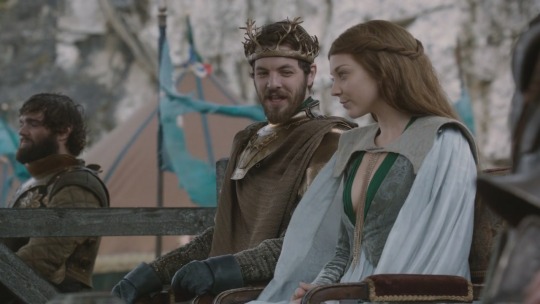
However, in this case, Margaery not wearing a crown is connected to her narrative arc. In the scene with Baelish where she proclaims that she wants to be THE queen, Margaery has come to realize that “Calling yourself a king doesn’t make you one”. She realizes that Renly wasn’t really a king and therefore she wasn’t really a queen. Clapton pays attention to details like this and that is why she didn’t make a crown for Daenerys in season 7:
Well, she's not the queen yet. You can't have a crown until you are queen. You can have the chain, but until you get the throne you're not queen. (x)
Thus, the fact that Margaery never wears a crown during her short-lived marriage to Renly is less about world-building and more about the narrative.
Thanks to @lilbreck for the edits.
122 notes
·
View notes
Text
I honestly feel like a part of the reason why i’m so disconnected and solitary is my bisexuality and androgynous gender and gender expression. Not those qualities in themselves, but the things I’ve experienced because of them.
(This turned into a pretty long, perhaps haphazard essay/rant but I’d be very glad if you stuck around to read through it. I’m not sure if I’ve ever talked to anyone, even my friends about all of these experiences in this much detail, so needless to say this will be a quite personal piece, but I would like it if as many people as possible read it. Though I’m talking about my own life, a lot of these things are universal for LGBT people and I think it’s important to talk about our experiences. Please feel free to comment your thoughts)
Ever since puberty began for me and my peers and, at first, mild forms of sexuality as well as a more... obvious form of gender expression became relevant, I felt estranged. At first I thought it was just the fact that I was a bit of a tomboy, and because I couldn’t care less about kissing boys I wondered if maybe, I was asexual. I couldn’t really relate to the girls, so maybe I should try to hang out with the boys instead? Except I didn’t feel like I belonged there either.
I didn’t care about conventionally feminine things like shopping, makeup, looking pretty and so on. But then I found out that the group of female friends I’ve sort of... loosely connected with and hung out with were talking behind my back about my clothes and the fact that i didn’t pay too much attention to my appearance. And my insecure 13-year-old self took that to heart. So I tried. I went shopping for trendy clothes, light makeup, I started doing my hair, I lost weight so I could have the ideal, somewhat underweight skinny figure. And things were... great. My friends didn’t talk behind my back anymore, all of them wanted to hang out with me, everyone in my class, including the boys, talked to me and joked around with me.
And then I just. Didn’t care anymore. It took so much effort to try to fit into that mold of an average teenage girl because that wasn’t me. So I pulled away from my class and most of my friend group, I focused on my hobbies rather than shopping or looking good, if I did wear makeup or buy new clothes I was going for a more alternative look, because that’s what lined up with my interests and my aesthetic or whatever, I went back to a normal weight.
But it wasn’t just a case of “oooh im so different from the normal girls, blah blah blah”. A friend introduced me to things like anime, j-rock and cosplay, and I found a world of ambiguous gender expression. Male musicians that looked androgynous or even feminine in makeup and elaborate costumes, female musicians who had an androgynous or even masculine appearance. Crossplay. It was a world I was immediately drawn to. And there was no pressure. No friends talking behind my back, I could’ve just brushed it all off, brushed it off as my best friend’s weird interest. But I couldn’t. Whenever I binded, put on a short-haired wig, and contoured my face to look more masculine, I felt amazing. Whenever my friends said I looked like a dude, it felt like biggest compliment imaginable. I could put on makeup and cool clothes, and be seen as androgynous rather than feminine, and I loved that. I became the outcast of my class, and now only had two friends to hang out with. But now I was much, much happier. I felt like my identity was going in the right direction. I didn’t feel quite so estranged anymore.
When I was 15, the aspect of puberty I had mostly ignored so far, came crashing down on me. I had played with the thought of dating before, I had asked out one of my friends because I was curious what dating was like, but couldn’t really get close enough to a boy to consider dating. Some aspects of sexuality I had discovered quite a while ago, like masturbation. I had had a few crushes over the years, but either I was too young to make anything of them, or they were just... vague and fleeting, one-week crushes. I got a crush on guy that was doing his civilian service at our school (an alternative to the mandatory military training Finnish men have to take as an 18-20-year-old), but he was way too old and I never got the nerve to talk to him.
But while I had that crush I was suddenly a bit fearful of girls. I was really nervous in gym class, in the locker room. I tried to change as quickly as I could and not even accidentally glance at anyone. Soon enough I realized I was scared that the girls might think I was a peeping Tom. I felt like a guy who had just walked into the wrong changing room and couldn’t escape. Except I wasn’t a guy. Or was I? At the very least I was starting to realize that when I watched shows like Game of Thrones, The L Word and so on, I found the sexy women... sexy. But I didn’t want to be a lesbian. I didn’t want anyone to think I was a lesbian. I was paranoid. I was a nervous wreck around girls, constantly over-analyzing my actions and words to make sure I didn’t come off as gay. I didn’t get along with boys and was generally avoided at all costs by them, but girls.. they talked to me. They were around me all the time, in gym class and in other classes. I’d sit next to girls if I couldn’t find a pair of desks that were both unoccupied so I could sit alone, because sitting next to a boy would subject me to subtle bullying, disgusted looks, looks that said “just fuck off you weirdo”. At least the girls didn’t bully me face to face, and what I didn’t know, couldn’t hurt me.
There were a couple of times before I graduated Middle School when my class seemed... aware. They said and did things that on the surface were harmless, but the hidden message was “we know”. One of the popular, pretty girls in my class tried to sit next to me. I was sitting alone and she’d already picked her seat elsewhere in the class, but she came over, asking if she could sit there next to me. I blatantly said no, and she looked taken aback. Was she surprised because the lesbian wasn’t frothing at the mouth to have a pretty girl sit next to her, or was it an act, and she’d go on to laugh with the others “she was so quick to say no, she’s definitely gay”. The most homophobic guy in my class would say something about a pretty girl, or talk about “the gays” and turn to me “isn’t that right, [birth name]?”
Maybe it was the subtlety, the room for interpretation, the hidden meanings and the context that stemmed from their own conversations, the context that I was unaware of. Maybe that was why I felt even worse, even more anxious than if they were to flat out call me “a dyke” or something. Always being on my toes, fearing when. When is it going to get worse? How long are they going to toy with me before the name calling starts, before I get beat up, before I get harassed? And it didn’t get worse. It went on for a couple months, and then we graduated. And I made sure to go to a High School as far away from my Middle School as possible. And once I started High School, no one from my old class was there. Only a couple people from the same Middle School, people who barely knew me and didn’t give a crap. Yet the fear was conditioned. Is it going to get worse now? Now these people, my new class have three years of time to realize I like girls, to toy with me, for the bullying to get exponentially worse.
At first I tried to make friends. My anxiety was terrible, I was constantly nervous, shaking, sweating, twitching. My face would sometimes flush, and I’d stutter while speaking. Heart hammering in my chest. Awkward face and head twitches that I prayed no one would notice. I was starting to get to know some people from my class. Everyone was very nice. We had fun conversations, we’d help each other with the difficult homework. I got a bit of crush on a guy who was funny and nice, who read a lot and said “in theory” a lot, even when he was talking about a practical application of something. Yet I also kind of liked a couple of the girls, they were pretty and smart, funny, one of them had similar interests as me. Maybe not crushes per say, but perhaps with time, they would turn into crushes. And I was still paranoid. And I was still waiting for them to figure out I liked girls too, for me to lose my new friends, for my whole class, including the guy I had a crush on, to gang up and start bullying me.
So I pulled away. I stopped talking to my classmates, I ate lunch alone, I spent the recesses alone. The first couple months everyone in the class had lessons together, but because in Finnish High Schools the students get to pick their courses - though many are mandatory, you get to pick which fifth of the school year to have that course, on which part of your weekly timetable, as long as the course is being offered by the school in that particular spot - only a small portion of my class would end up on the same lessons as me, and sometimes no one from my class would be there. Sometimes we’d have to sit in groups and inevitably I’d talk to people and get to know quite a few people from different classes, but mostly through teacher mandated discussions, exercises and so on. Outside the classrooms I was entirely alone, only speaking to people if I had to, never revealing too much of myself, especially my sexuality.
And the funny thing was, I went to a liberal Art High School. A big portion of the students were on advanced Art courses. And the people there were open-minded, because at least half of us were the types that had been outcasts in Middle School. There were lesbian couples, trans guys, a trans girl, a non-binary person. There was an event where the whole school was present, panelists talked about minorities, equality and the like, and when it was time to take audience questions, this one guy asked something and casually mentioned that he’s pansexual. And no one gave him shit. No one cared. Oh, you like guys and girls? Ok, cool. What’s your favorite band? Do you like (insert whatever hobby here)? Have you seen this meme? DO YOU LIKE PINEAPPLE ON PIZZA?
I spent three years in as much solitude as possible, I didn’t try to make any friends in school, because of an irrational fear. No one in my school would have cared that I was bisexual. Hell, if I had bothered to talk to more people I could’ve found an entire friend group full of bisexuals and pansexuals. Instead I focused fully on my schoolwork (and my free time interests) and settled for useless crushes on people I never talked to. At one point I had crushes on 4 different boys and probably double that amount of girls, and I’d only had a few conversations with each of them, always in the classroom, always during a group project or a philosophy dialogue or some sort of merry go round the classroom and exchange some answers to a question or little presentations or whatever.
And I think my High School experience was a usual, yet somewhat unusual example of navigating a heteronormative world as a bisexual. I was in a constant state of fight or flight, trying to survive any potential homophobia or even biphobia that could be thrown at me. In some other High School, this would have been the best course of action. Just a couple kilometers away from my school was a Sports High School, notorious for, let’s just say less than intellectually curious or open-minded sporty guys. There my tactic of avoidance would have been advisable. Make friends outside of school if possible, do not engage people in the school. But I spent three years in probably the most open-minded and anti-bullying High School in my city, and already within a couple months I had met a lesbian couple, two trans guys and probably many more lgbt people who didn’t happen to outwardly express or talk about things in those few moments in the classroom that would have hinted at their identity. Three years, and I just. Stayed the same. My anxiety was still too bad during first year, second year I just wanted to focus on school and figured I’m just a lone wolf, and I’m fine not really having friends, and by third year I figured it was too late to make friends now. And then I graduated.
And while my sexuality was the biggest reason for my alienation, my gender and gender expression were still there as well. I presented as female but not overly feminine for my first two years of High School, which somehow added to my paranoia of being seen as a lesbian. I never really felt a connection to either gender, or that core feeling of “i’m definitely a woman” or “i’m definitely a man”. I don’t know why. Maybe it’s hormonal or otherwise biological in part, maybe it’s in part due to my bisexuality, never feeling like I belong with the girls or the guys, even though sexuality doesn’t equal gender and vice versa. Maybe it’s because my mother wasn’t feminine, and my parents didn’t really force feminine gender roles on me growing up. Maybe it’s just how my brain works. With indifference towards “a gender identity” and a need to not be gendered. To appear androgynous. To be masculine when I’ve been as female for too long. To be feminine when I’ve been seen as male for too long.
I identified as agender in my second year of High School, I tried to tell my mom but she didn’t understand, and started using an abnormal amount of gendered (feminine) words about me. And I felt horrible. I hated everything about me that made me look so feminine in the eyes people around me. I hated my boobs, I hated my long hair, I hated my curvy figure. It went on for some time, and I started thinking... maybe I’m a trans guy. Maybe that’s why I hate being seen as female, why I felt like a boy trapped in the girls’ locker room in Middle School. I cut my hair short. I started binding again. I wore masculine clothes. I tried to deepen my voice when talking. I switched my hand bag to a back pack. I started trying to lose weight. I started using the name “Alex” online. I didn’t choose it because it was masculine. I chose it because it’s gender neutral. At first I thought it was because that way I could change my legal name before transitioning. Now I think it’s because of the gender neutrality itself.
I started getting more involved in the tumblr gazette fandom, making all sorts of shitposts, commenting on posts a lot, being social. And I started making friends again. I didn’t know them in real life, but I still considered them my friends. I’ve always wanted to travel as much as possible, and having friends all over the world means the trips abroad I’m planning on making can also double as visiting my friends. I got into my first relationship with one of my online friends, and though it didn’t work out because of the distance, we’re best friends now. I’ve made many great friends online, and I definitely want to keep being friends with them. They’ve been the first I’ve been able to properly come out to and who have accepted me as who I am, and I’m forever grateful for that.
My friends online were the first to call me by my chosen name of Alex and refer to me with male pronouns and words. And it meant the world to me. It eased the discomfort of mostly being seen as female by my family, by people at school and so on. Over the past year or so I’ve given my parents hints about my gender identity and my sexuality, but either they haven’t caught on or they won’t make a big deal about it unless I come out to them in some form. Maybe I feel like it doesn’t matter, maybe I’m scared to come out fully to my parents before I’m on my own and don’t need their financial support, don’t need their presence or their love or their acceptance. My parents have some gay friends and generally haven’t expressed homophobic opinions or behavior, but it might be different when it’s their own kid who’s queer.
Being seen as male by my friends and female by others was fine for some time. Strangers on the street would sometimes look confused looking at me, not exactly sure whether I’m a very butch girl or a guy with a curvy figure. I felt like I was starting to teeter more towards people interpreting me as male than female. And suddenly, I started hating the masculine things about myself. I stopped binding. I stopped cutting my hair short. I started doing my makeup again, though almost always just for selfies. For my graduation, I wore a suit. A few days after graduation I went shopping and bought a dress and some feminine accessories. I started feeling the pressure of needing to lose weight even more heavily than before. I look hideous in a dress. I need a slimmer figure. It was a familiar feeling, it was like 7th grade, but different. No one was pressuring me to be feminine. Yet I felt an even more dire need that before to be feminine.
I’m identifying as agender again. I’m not a man, but I’m not really a woman either. My biological characteristics are what they are. Some days I hate my boobs and want a flat chest, some days I think they’re sort of nice. Some days I want to look as feminine as possible, to have long hair again, to wear my makeup especially pretty, to have the figure or the confidence to wear my dresses. Some days I relish looking androgynous, some days I want look like a guy, deepen my voice a bit, wear a confident smirk, hide my boobs, inhabit the space around me in a more assertive way. I don’t have crushes currently, but I see some women and men and I feel attracted to them. I wish for a cute goth gf. I wish for a bf/gf or a non-binary partner who understands me, who inspires me, who challenges me intellectually. Yet part of me says I could never have that, that I’m unattractive and a loser. But part of me says, who knows. Part of me says, hell yeah, you deserve it! If not in a romantic then definitely in a platonic sense. It took me a long time to accept the same-sex part of my attraction but now that I have, I want to just go out and meet cute girls, I want to talk about girls and I’ve filled my playlist with wlw songs, I want to draw cute girls, and just. G I R L S!!
But I still lack the confidence. I’m still nervous, though much less than before. I’m afraid that me and my girlfriend will have to hide behind a platonic illusion in public, or even among some of the people in our life. I’m afraid we’ll get harassed or even assaulted. I’m afraid the same will happen with my non-binary partner when we’re both presenting and reading as very feminine or masculine. Hell, if I lose enough weight, wear baggy clothes, cut my hair short again and contour my already androgynous face to look masculine, some shitblossom on the street might even call me and my boyfriend “faggots”.
It’s so much easier to just stay in my shell, not get close to people, not risk getting crushes or dating. It would be devastating to make friends with people who I have things in common with and who are fun and inspiring to be around, only for them go “haha, yeah, it’s just a phase” “you’re a woman and that’s it, stop with that special snowflake bullshit” “oh so you’re a cheater” when I tell them I’m bisexual and identify as non-binary. I probably won’t come out to my family for a year or two, or maybe I’ll only come out once I change my name, or once I have girlfriend or an afab partner.
I’m an introvert, I’m cynical, I like being alone, I’ve been more of a lone wolf since childhood, preferring to play alone, preferring reading and drawing over sports or other social hobbies, I can be very critical of people and get socially exhausted easily. But I’m also afraid of making connection, making friends, dating, being fully open and honest with my family, because I’m a bisexual in a heteronormative society, because I genuinely do not feel fully female or male in terms of social gender and gender expression in a world that says you’re either a man and male or a woman and female.
And next time that negative part of me tells me I’m going to live my life alone, I’ll realize it’s not because I’m unlovable or a freak. In part, it’s because I’ve been conditioned, like so many other LBGT people, to be constantly on edge, in a near constant state of fight or flight in a society that should be full of other humans, of friends, acquaintances, humanity and solidarity, but appears full of tigers and lions and snakes just waiting for us to make the wrong move and devour us.
It shouldn’t be the case. Not even the majority of straight cis people are homophobic/transphobic (in most western societies), yet the fear that the minority conditions us to have can so easily become generalized, to the point where we might want to avoid all people as much as possible, to disconnect ourselves from everything. Sometimes the only way to be free of that fear, even occasionally, is to just surround ourselves with people who are also LBGT. But I’d like to see the day when we won’t have to fear any more than the average straight person. I’d like to see the day I could make friends without checking that they’re LBGT first, without fearing the potential discrimination and rejection when I happen to mention my girlfriend in front of a straight friend. I’d like to see the day when I’m not cooped up in my room listening to Hayley Kiyoko with the headphones on so my mom doesn’t hear, wondering how different the past few years could have been if I hadn’t been so damn afraid.
3 notes
·
View notes
Text
'S Wonderful: Costuming “An American in Paris,” Part II
Good afternoon everyone, and welcome to Part II of my review of Bob Crowley’s beautiful designs in the stage musical An American in Paris! Yesterday we took a look at the designs for the character of Milo Davenport, and today I want to look at the female lead, the character of Lise Dassin, as played by Leanne Cope in the original Paris and Broadway productions. Whereas the character of Milo is a stylish sophisticate, the character of Lise is a bit more down-to-earth, a charming ballerina who ends up falling in love with the male lead.
Some of these costumes are quite simple, and I like that about them; they give the character a clean look and allow you to focus more on the actress’ movements. Given the character is a ballerina, that’s not unimportant. Let’s take a look at some of Mr Crowley’s designs:
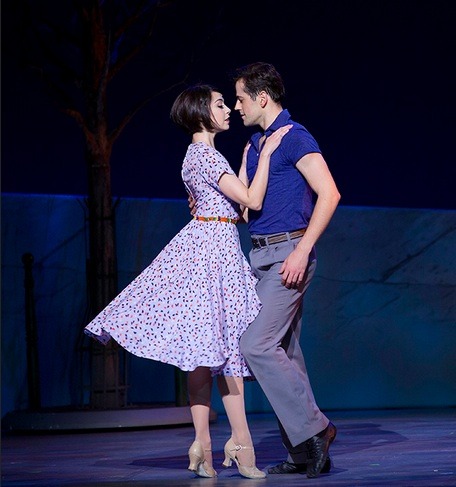
In general, I’m not a huge fan of polka dots as a pattern, but here I think that it actually works quite nicely. The dress itself seems to be a very, very pale purplish white that shows up well against the dark staging of the production. The skirt has a beautiful cut that allows the fabric to flow and twirl nicely, which is a great nod to the character being a ballerina. The dots are in shades of red and blue, and while sometimes polka dots can distract from the overall costume, here I think they complement the design. Rather than being in an orderly, geometric pattern, Mr Crowley has chosen to with a more randomized design. While that has the potential to go awry, here it puts me in the mind to think of flower petals or cherry blossoms floating down from the sky. Indeed, against the light coloring of the dress, that effect comes through even more. There’s a celebratory feel to it, and the relative lack of adornment helps it to stand on its own. It’s a clever piece that turns one of my least favorite patterns into one of my favorite costumes from this production.
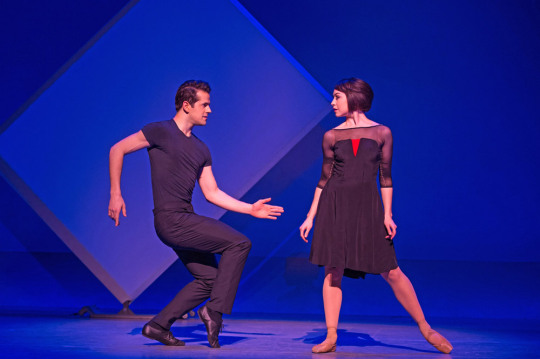
This number is sleeker and a bit more “sexy” than a lot of the costumes in the production, as well as avant garde for a production set in the 1940s. The shape of the dress itself is relative simple, and the fabric allows it to form folds that will open as the actress and character move around the stage. Given the elaborate choreography of An American in Paris, that is most definitely a good thing. The monotony of the black--in which Lise and the male lead, Jerry Mulligan (as played by danseur Robert Fairchild)--is broken up by just the slightest bit of red on Lise’s bust, a triangle in the center of the fabric. But what makes this dress a bit risqué for the era is not the length or the fabric itself, but the adornment on the upper chest and arms. Using netting in a dress is always an interesting choice, because it adds a kind of sexual allure; think about how it’s used in productions like Chicago or Sweet Charity for a comparison. Here, it causes Lise to look just the slightest bit more forbidden than if her shoulders were bare.
I think that has to have been an intentional choice by Mr Crowley, and it draws a nice contrast to Milo (who is the competition for Jerry’s affections in the musical). Her seductiveness is in the richness of her wardrobe, whereas Lise goes for something much simpler, offering a hint of sensuality in this costume rather than being overt. It’s very clever, and it’s something I haven’t seen a lot of outside of this production.

I haven’t talked much about patterns in this production, because there haven’t been a ton of examples, but this yellow dress worn by Lise is one that deserves some commentary. With a basic white fabric, the pattern is in fact a floral, but one that takes inspiration (I think) from ferns and plants rather than flowers directly. There are more sharp edges in the emblems that cover the dress, and less in the way of flowing blossoms. And that’s okay; the overall effect imbues the costume with a sense of excitement and motion, even while Lise is (as in this still) holding a pose as part of a dance or performance. The color is a nice choice as well, adding some warmth and glow to an austere set design (which is, I would note, intentional). Notice the way that this costume allows your eye to travel right to Lise, even though she’s in a close pose with Jerry; the yellow absolutely pops and makes sure you pay attention both to the dress and to the woman wearing it. That’s not necessarily difficult to do; balancing light and dark is Costuming 101. But what is interesting is that it’s done with a pattern, and one that fits the production rather well indeed.

Taken from another angle, you can see the floral portion of the pattern a little bit easier. The dress actually has an interesting cut to it around the bottom and doesn’t appear to be designed to lay perfectly flat; that’s a neat effect, especially when the actress is in different positions throughout her time in the costume and on stage. I also love the lack of a definite waist in this dress; it allows the pattern to be continuous rather than being artificially broken up.
That, for me, is a must with a patterned dress and costume. Breaking up the design should be done sparingly or not at all, unless it’s a repeated design (say, a geometric pattern) or a randomized one like the dotted dress above (and even there, the interruption is small and complementary with a thin belt). Maybe it’s not a sign of genius, but leaving this one alone has helped to improve its overall appearance considerably.
There is one more outfit I want to take a look at in this review, because it’s the one that comes closest to the “stereotypical” ballerina look without being too much of a tutu. Lise ends the musical and the actress takes her bows in a rather nice pink number (I seem to notice a theme with that...Roman Holiday, War Paint, An American in Paris) that deserves some special examination. Take a look first at the dress as it’s seen onstage, in motion and from a slight distance:

There’s a kind of softness to this dress that none of the other costumes possessed in the musical that I observed. The pink is a light, soft, cotton candy color that absolutely pops against the blue stage design and still manages to be a contrast to Lise’s dance partner. It has straps, which I think fits the idea that Lise is a bit more of an ingenue than Milo and wouldn’t really wear something entirely baring (black ballet number above notwithstanding), and the skirts flow in an almost satiny display. But what I like most about this dress is that it’s not one cut of fabric. Rather, it’s a number of layers of a sheer chiffon or chiffon-like fabric that combine to form the pink color. On their own, the chiffon layers would look almost translucent, but in combination they soften the color and make the dress pop even more. You can sort of see the end of one of the layers in the lower left of this picture, just above Lise’s right (viewer’s left) foot. But there’s an even better closeup from the bows that shows what I am talking about:
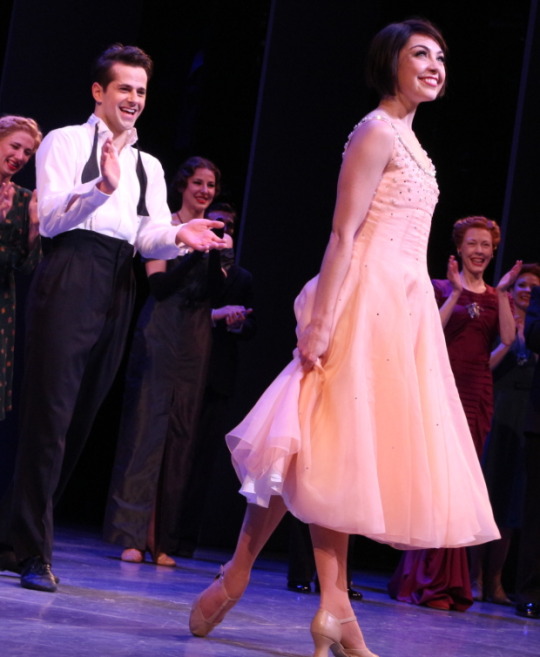
You can see that there is a white underskirt to provide a solid background for the chiffon to rest on, and that helps to brighten the color just a tiny bit. But the real work of the dress is in the ultra-thin, sheer layers of chiffon that combine to give that really eye-catching pink color. It’s so utterly soft and feminine in comparison to the staging for this production that I can’t help but really admire it.
If you look closely in this still as well, you can see that the bodice of the dress has a bit of beadwork on it that’s rather subtle, but definitely designed to help this gown catch the light and create an even more memorable effect. I think that it was needed here, despite the perfection of the fabrics, because otherwise there really would have been no adorned costumes for the Lise character. Adding some simple beadwork to the bodice is also a nice tip to the ballerina origins of the character and the ballet costume styles that would have been popular in an era contemporaneous to the one in which An American in Paris is set.
Overall, I’m a fan of Bob Crowley’s designs for this production. He designed two very different sets of costumes for two very different characters, but managed to give them all the delightful themes and styles of the 1940s. This is an elegant production that takes its cues from couture design and high fashion, and which still managed to make the dresses understandable to a modern audience who does not follow fashion religiously. All in all, it’s a fantastic outing and I really can see why Mr Crowley earned a Tony nomination for them. Absolutely spectacular!
That about wraps it up for my commentary on An American in Paris. I’m still deciding what show to review next after a jam-packed week, so look out for a preview post in the next day or so with a teaser of the week ahead. And as always, thank you for reading, liking, commenting, and reblogging!
12 notes
·
View notes
Text
Chuck Liddell On Dancing With The Stars
Donny Osmond and Kym Johnson - A lot regard to Donny Osmond for dancing up a storm regardless of the reality that he has an insanely busy routine (his Vegas show runs 4 evenings a week). Donny and Kim pulled off an incredible Argentine Tango and it was mirrored in their rating - an incredible 29, the greatest of the season.
Aaron Carter and Karina Smirnoff. the original source has toured the globe and sold hundreds of thousands of information as a teenager pop sensation. He is presently the youngest solo artist to have four Leading forty singles. His companion Karina Smirnoff has been competing on DWTS because Period three, and completed in second place with partner Mario Lopez. Her other companions consist of Billy Ray Cyrus, Floyd Mayweather Jr., Rocco DiSpirito, Mario and Steve Wozniak. Because of Aaron's youth, this couple may struggle, but on the other hand, they might surprise even the toughest critics. Their future on DWTS could go both way. Stay tuned.
youtube
Chuck Liddell and Anna Trebunskaya. Chuck Liddell is a mixed martial artist and ultimate combating champion. He also penned his own autobiography known as Iceman: My Combating Lifestyle, which quickly became a New York Occasions Bestseller. His partner Anna Trebunskaya has been concerned with DWTS on and off since season two when she made it to the finals with companion Jerry Rice. Her other partners consist of Albert Reed and Steve Guttenberg. With Steve's strength and Anna's grace, this few may surprise the judges and the voting audience.
Aaron Carter Chris Crocker
"The Addams Family aaron carter aids members" theme song written by Vic Mizzy. Even though The Addams Family only aired from 1964-1966, its theme song stays massively recognizable.

Natalie Coughlin and Alec Mazo - How about that costume Natalie was rocking? I'm lovin it! But that cover version of "American Woman" she and Alec danced to was completely heinous. I believed Natalie and Alec's Paso Doble was superb, but the judges obviously didn't agree. Score: 22.
Grammy Successful singer/songwriter Joss Stone took to the phase with her single Free Me when the Dancing with the Stars results display ongoing. I don't know about you, but when I appear at Joss Stone and her fairly face and girly hair, and then listen to her sing, I'm always shocked by the cacophony in between the sight and the sound. Her voice is lovely, I believe, but just not what I at any time expect. In any case, she was joined by a pair of professional dancers performing their thang on the ballroom floor. It looked like an elaborate bed room dance, if you want my viewpoint.
Aaron Carter Party
And Joanna Krupa (who)? Let's just say the reason she is nonetheless in the top 5 is simply because of Derek Hough. Anyone who is lucky enough to get him as a partner is heading to adhere about for awhile. He is, by far, the very best dancer on the display (as nicely as Mark Ballas). Derek has some of the best choreography and should truly be a fantastic teacher since he goes a long way on each display.
The new period of "Dancing with the Stars," is becoming billed as the biggest period yet. 16 celebs will be competing for the title of "DWTS" Winner. It all kicks off with a live three evening premiere beginning tonight at eight p.m. on ABC. Donny Osmond, Aaron Carter and previous House Majority Leader Tom Delay are amongst the contestants.
But what Keara delivers to the table is not an additional fairly encounter with a good voice - it is, rather, a unique mixture of musical skills that are adept far past her many years, matched with a serene, but youthful, vitality that keeps her relatable to audiences of all ages. With an R&B acoustic sound relatively reminiscent of a younger feminine counterpart to Bruno Mars, Keara (or 'guitarprincesskeara' as she's recognized to her 3000+ subscribers on YouTube) is prepared to bring a new edge to teen pop songs. I sat down with Keara just a few nights in the past prior to an exceptional performance supporting Web Site at the Concert For Our Future in Manville, New Jersey, exactly where she opened up about her desires and goals for her promising long term in music.
youtube
Aaron Carter 2000
Carrie Anne commented that whilst it was apparent he hadn't danced before, she favored that he respected the dance and display the joy of dancing, but he has to discover to use his heels.
Case in stage, singer Mya and design Joana Krupa. These girls are undeniably great dancers and probably the leaders of the competitors. But who cares? Many viewers don't know sufficient about them to get invested and root for them.

Aaron Carter 2016
Post-an additional split, Chuck Liddell and companion Anna Trebunskaya, Melissa Joan Hart and partner Mark Ballas, and Kelly Osbourne and Louie van Amstel were proclaimed secure, while Louie Vito and Chelsie Hightower were relegated to the dreaded hazard zone. Oh no, not my puppy canine boy! By the by, the Hazard Zone is my own terminology. I'm throwing myself a bone right here and making my own DWTS vernacular. Heck yeah.
Donny Osmond and Kym Johnson. Donny Osmond currently appears with his sister Marie (the past DWTS competitor most well-known for fainting throughout a display) at the Las vegas Flamingo Hotel. Donny has been a singer, musician, actor, talk and game show host and very best-promoting author. He would love nothing more than to progress higher than sis Marie did. His partner Kym Johnson has been on DWTS because Season 3 when she was paired with Jerry Springer. Other previous partners include Joey Fatone, Mark Cuban, Warren Sapp and David Alan Grier. This few should mesh well and do well in the competition, maybe giving Mya and Dmitry a operate for their money.
Age has not been type to the sixty eight year previous music producer. Phil Spector -- who can name John Lennon, the Righteous Brothers, Leonard Cohen, and George Harrison amongst songs's greats related with him - was lastly convicted of 2nd degree murder in the loss of life of Lana Clarkson. His booking photograph - the now famed Phil Spector mug shot found on the Cigarette smoking Gun - provides increase to speculation that pretty a lot any sentence handed down on Might 29 will be a life sentence.
0 notes
Text
Something revealed about Mary and Elizabeth as costumes separate women from myth
Modern women will recognise the dueling monarchs in Mary Queen of Scots.
By Janice Breen Burns
7 January 2019 — 11:30am
For 400-odd years they've been cast as the flinty bitch and the bed-hopping slut. Elizabeth 1 and Mary Stuart were royal cousins vying for legitimacy in a kingdom rent by religious and political conflict. Their rivalry became the stuff of legend, such that more than 400 years later, filmmakers are still finding riches in the royal rancour.
Josie Rourke's Mary Queen of Scots extracts its female leads from myth and history. Starring Margot Robbie as Elizabeth I and Saoirse (pronounced "Sur-Sha") Ronan as Mary Stuart, the film tenderly fleshes them out enough to chime with real women today.
Mary Stuart's attempt to overthrow her cousin Elizabeth I, Queen of England, finds her condemned to years of imprisonment before facing execution.
"That's what I wanted most in the telling of this story; to show all aspects of what it's like to be a woman," Rourke says. "To show all aspects of all women's experiences, all women's bodies, and that fight for control that's still real."
Critical flack for the film's rejigging of history (including a face-to-face meeting of the queens that never happened) was inevitable. But Rourke and co-producer Tim Bevan (both Elizabeth films starring Cate Blanchett were also his) are unapologetic. "[The screenplay] took us away from exact detail," Bevan says, "but it captured an emotional truth and atmosphere."

Rourke is more blunt: "Mary's been slut-shamed for the past 400 or so years," she says. "I think she's been done a bit of injustice by history." She reckons the film might help right a wrong that's embedded in history's mechanics, particularly its recording by men about women.
"Mary was framed as this kind of femme fatale by Cecil [Lord Burghley, adviser to Elizabeth 1, played by Guy Pearce]," Rourke says. "It was a systematic campaign; letters, pamphlets, fake news as we'd call it today."
Cecil's slut tag stuck, as did Elizabeth's "Iron Queen" stamp. But the film adds delicate dimensions of vulnerability, vanity, self-doubt and naivete to their documented surges of political strength and resolve.
Much of the intuitive material about them was spurred by a new biography of Mary Stuart, My Heart Is My Own, by forensic historian John Guy. "He put aside this 400 years of writing about Mary as someone who was incompetent because she couldn't control her emotions or sexual appetite," Rourke observes, "and he basically said 'What is actually in the archives? What actually happened?'."

Or, what was most likely to have happened, given both young queens reigned in the same social soup; despised for their gender and manipulated by power-mongering courtiers.
"Imagine starting a new job like that," Rourke says. "Being handed this ton of responsibility, but you're surrounded by people who doubt your abilities and even your right to be there. They want to control who you marry. They want you to produce a male heir. And, in the end, that's your power and your triumph but, when you do [as Mary did, giving birth to a son who eventually ruled England and Scotland as James 1], there's always going to be some uncle or brother around who goes: 'Well that's incredibly useful; I wonder if we need you any more, queen? Maybe I can just rule on behalf of your son...'."

Women's power was woefully limited and tied to their physical appearance and value as brides, mothers and whores in the 16th century. Among Rourke's key allies in conveying this for the #MeToo era were hair and make-up designer Jenny Shircore and costume designer Alexandra Byrne.
"I knew when I first read the story we wouldn't be making a historical documentary here," Byrne says. "And I didn't want to do a, 'here comes another queen in another frock' either."
This rendering of 16th-century fashion would be different, she decided, but not crazily different. Byrne used her extensive knowledge of the era's authentic fashions as a scaffold for the new costumes she describes as "engineered to express how [Elizabeth and Mary] ruled and maintained their power in a world of predatory men".
Elizabeth's elaborate, multi-level carapaces of heavy silk brocades and gauzy laces were relatively easy to sculpt as the peacockily political crowd-pleasers they were meant to be, from the typical toolbox of figure-altering farthingales, corsets, crinolines and other boned and padded fashion contraptions of the time. Mary's, on the other hand, had to be simpler, more subtly nuanced, more Scottish, more modern.
"Elizabeth was incredibly aware of the power of her appearance," Byrne says. "She actually aimed to replace the iconography of the Virgin Mary."
In the earliest years of her "virgin queen" persona, Byrne envisions Elizabeth's intention complicated by the vanity of a typical young woman. "She's like the girl with the Net-a-Porter account, using everything she can buy to create the look," Byrne says, laughing.
Byrne introduces elegant glints of copper and bronze into Elizabeth's fragile funnel collars as the young queen might have done herself, to enhance her red hair. But then she bleeds all colour and joy from the queen's wardrobe as a disfiguring bout of small-pox thins her hair, pocks her complexion and guts her self-esteem.
By the film's crescendo, shot as the queens move evocatively towards each other through drifting white veils of freshly washed laundry, Elizabeth's shattered ego is heartbreakingly evident.
Byrne chose a striking hunting ensemble for her to wear, but confuses its impact with extra, intensely self-conscious, fashion choices: a clownish red wig to cover her thinned and ratty hair, and make-up trowelled on, pale and thick as Spakfilla, to cover her pock scars.
Any woman who has ever been tempted to paper over her self-doubts with fashion might recognise the OTT, mutton-as-lamb result. And in these cringlingly feminine stakes at least, Mary's messy hair, battle-spattered dress and careless disregard for her own youth and beauty, effectively "wins".
Byrne's trick, to infuse a relatable sense of modernity into costumes including Mary's and the male characters, was to cut most of them from acres of indigo denim. "We have this association with denim in our everyday lives that gave me that juxtaposition of ancient and modern I needed."
Rivets, stitching and patinas of sweat and mud only enhanced the costumes' contemporary cool and in clusters, they cast an oddly satisfying blue across the film's moody chiarascuro.
Best of all though, was denim's boon to Byrne's male costumes, "which had to be sexy ... with a swagger". Story lines including Mary's flirtation with future husband Lord Darnley (played by Jack Lowden), swung on how convincingly hot he was to modern audiences, not likely in swollen breeches, fancy doublet and tight.
Byrne experimented with leather and denim and solved the problem of Elizabethan sexlessness with high-waisted crotch-centric pants and low-slung western belts and, voila, "we had our swagger".
In any final analysis of Byrne's intuitive reimagining of Mary, however, her simplest costume design is the most evocative. Ronan strips down to a rough chemise in a scene that could could only be described as a rape, but one that Mary orchestrates herself in order to get pregnant.
"She's been at the battle, she's dirty, she's sweated into that chemise," Byrne says. "It's very much a garment that's of her." After Darnley's departure, Ronan curls up, all pale girl legs, tangled hair and grubby chemise, but not as a victim. On the contrary, she knows the shocking limits of her power as a woman, and prays his sperm will take.
Source: Sydney Morning Herald
youtube
0 notes
Text
Mozart!

For my first post, I would like to share my thoughts on the musical “Mozart!” that toured across Japan from Tokyo to Osaka and Nagoya between May and August of this year. It’s been almost three months since I went to see it at the Imperial Theatre, but it made such a deep impression on me that I’d like to look back and share some of my memories of it.
“Mozart!” is originally a musical written in German and was first performed in Vienna, Austria in 1999. The production first made its way to Tokyo in 2002, with multiple revival performances since then, and the production this year was its sixth time in Tokyo. The story outlines the life and career of the composer Wolfgang Amadeus Mozart, mainly focusing on his rise to fame as a composer and his inner conflicts as he wrestles with both his musical talent and human society.
The production in Tokyo this time starred a double casting of Yamazaki Ikusaburo and Furukawa Yuta for the role of Mozart, with a triple casting of Hirano Aya, Ikuta Erika, and Kinoshita Haruka for Constanze. The particular evening show I went to see on June 9th had Furukawa/Hirano as the main cast. I originally decided to see the musical because I was a fan of Furukawa-san, for whom this would be his first starring role at the Imperial Theatre. But after watching the actual musical, I was simply blown away by the story, the music, and the amount of emotion that was embedded in this production.
Firstly, the stage was built around a revolving set made of wood, with one side of it made into the shape of an open grand piano, and the stage itself was framed with an illuminated musical staff. For scenes that involved the entire cast, the ensemble would sing from the steps on the side of the piano, while the main characters usually moved about below them. The simple and versatile design of the stage allowed a limited but sufficient use of other props and accentuated the elaborate costumes worn by the cast. The costumes were a mix of the modern and the traditional, using denim, embroidered patches, and painted text to create a rock-ish style. One of Mozart’s long coats even had “1756”, the year he was born, written on it.
Before watching the musical in Japanese at the Imperial Theatre, I watched some footage of the 2015 production in Vienna. In the Austrian production, the costumes didn’t have so much of a modern touch to them compared to the Japanese production, with Mozart wearing a loose, white outfit that, in my opinion, gave a more innocent impression, whereas the colourful, rock outfits in the Tokyo production emphasize the rambunctious side of the characters, as if to reflect their individual, rebellious attitudes towards society at the time.
In “Mozart!” Mozart’s talent is personified as a presence called Amade, played by a child dressed as a miniature Mozart and visible only to Mozart himself and the audience. It follows Mozart all the way from the beginning when Mozart is serving under the archbishop of Salzburg, to when he moves to Vienna, meets and eventually marries Constanze, and rises to fame before reaching his pinnacle and is killed by his own talent. In the ending scene, Mozart stands on top of the set facing a fictional audience in a theatre in the background, his back to the real audience. He finishes his performance on the piano and bows deeply, over and over, to the cheering crowd. The ensemble sings Kage wo Nogarete (“Escaping from the Shadow”) for the final time, before Amade stabs Mozart’s arm with its quill, ending his life.
I thought the idea of Mozart’s talent being portrayed by Amade was ingenious. Amade, quiet and innocent in its own existence, is but a child that continues to write music. It follows Mozart in every scene and waits for him as a constant presence—beside him, on the piano chair, under the piano, at his desk. Mozart’s inability to separate from Amade is portrayed as neither negative nor positive—Amade simply exists, even as Mozart’s life progresses around it.
The songs in “Mozart!” were simply works of art, both music and lyrics. One song that particularly appealed to me was Zankoku na Jinsei (“The Cruel Life”), sung by Mozart just after he discovers his mother dead. It depicts the foolishness of human society, its indifference even as your own world turns upside-down, and the futility of life as a human being trapped by both mortality and society. It really portrays the essential fear of all human beings, that life can be so precious and full of warmth, yet it can be lost in a moment, and the world not affected in the slightest.
My impression of the Mozart played by Furukawa-san was an irresponsible, happy-go-lucky guy who had so much aspiration and wanted a lot out of life, despite his limited capabilities in reality. He wanted to be famous, wanted to go to a faraway place for adventure, wanted love in his life, wanted his family to be there to support him… and at the same time, his overwhelming love and talent for music is so tolling that he finds himself unable to juggle everything that he wants. Yet he still refuses to acknowledge this fact, and continues to live free from responsibilities while the others around him suffer. He eventually comes to the realization near the end that his lack of attention towards those around him has costed his loved ones too much, even their lives.
In the scene where Mozart receives news that his father had passed away and he collapses onto the edge of the piano, sweat dripping down his neck, Furukawa-san wore such a painful expression that I could feel almost a physical pain seeping into me as I watched. (It made me worried that he was actually in pain.) Baroness von Waldstatten appears on the top step of the piano and sings Hoshi kara Furu Kin (“The Gold that Falls from the Stars”), and the lyrics ai to wa hanarete ageru koto (“love is to let one go”) really sink in as Mozart realizes the true immensity of his father’s love for him, albeit too late. The song summarizes the uncontrollable curiosity and thirst of the child, and a parent’s transcending sacrificial love. Even after the musical, I tear up every time I listen to this song.
Another aspect I particularly enjoyed about “Mozart!” was its portrayal of its female characters. Hirano-san’s depiction of Constanze was strong yet feminine, and very human. But the female character that resonated with me the most was Mozart’s older sister Nannerl, played by Kazune Mio. She always believed in her younger brother, even when he couldn’t attract an audience with his music. She sent him letters when he was in Vienna and comforted their father, she got married and provided her brother with financial support even when he wasted the money away, and she always looked after her family members despite having limited options as a woman at the time. In the end, after their father passes away, she finally says to Mozart, “I won’t forgive you”. In those words, I felt that the love and despair she held made her such a strong character. I really appreciated how the musical portrayed these sides of the women in Mozart’s life.
All in all, everything about “Mozart!” was amazing. The depressing, yet very real and beautiful feeling that it leaves the audience with when it ends is spectacular. If possible I would have liked to see it again, but it was a highly popular production and the seats for all the shows in Tokyo had already been sold out way ahead of time. It left me with a lot of thoughts of my own, and I find myself still bathing in its afterglow even now.
I look forward to its next performance in Tokyo.
-- Official site: https://www.tohostage.com/mozart/
0 notes